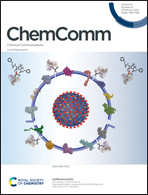Gram-scale synthesis of single-atom metal–N–CNT catalysts for highly efficient CO2 electroreduction†
Abstract
Single-atom catalysts (SACs) have attracted much interest for electrochemical CO2 reduction because of their high metal utilization and excellent catalytic activity. However, the practical applications of SACs were restricted by the low production yield. Herein, we developed a facile synthetic strategy for fabricating metal–nitrogen–carbon nanotube (M–N–CNT, M = Ni, Co, Cu, Fe, Mn, Zn, Pt, or Ru) SACs at scale (>1 g) by direct pyrolysis of metal cations, phenanthroline and CNTs at high temperature. The pyrolysis leads to forming coordinated Ni–N active sites anchored on CNTs. The prepared Ni–N–CNT catalyst with a remarkable Ni loading of 2 wt% determined by ICP exhibits the highest activity for CO2-to-CO conversion with a high faradaic efficiency of 94% and excellent stability. Aberration-corrected high-angle annular dark-field transmission electron microscopy, X-ray photoelectron spectroscopy and X-ray absorption spectroscopy confirm the presence of isolated Ni single atoms in Ni–N–CNT, which act as the active centers for CO2 electroreduction while the CNT support offers fast pathways for electron and mass transports. This work laid foundations for future practical applications in CO2 electroreduction, oxygen reduction reactions, water splitting and nitrogen reduction and beyond.



 Please wait while we load your content...
Please wait while we load your content...